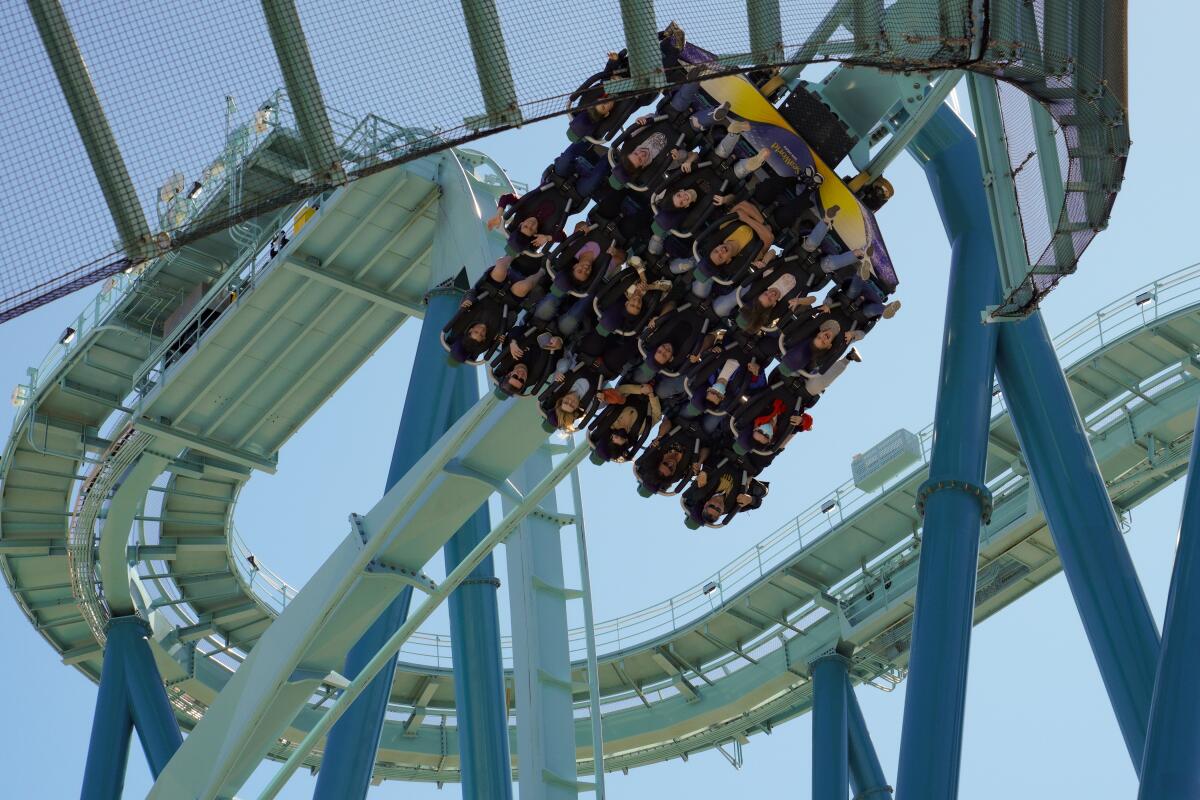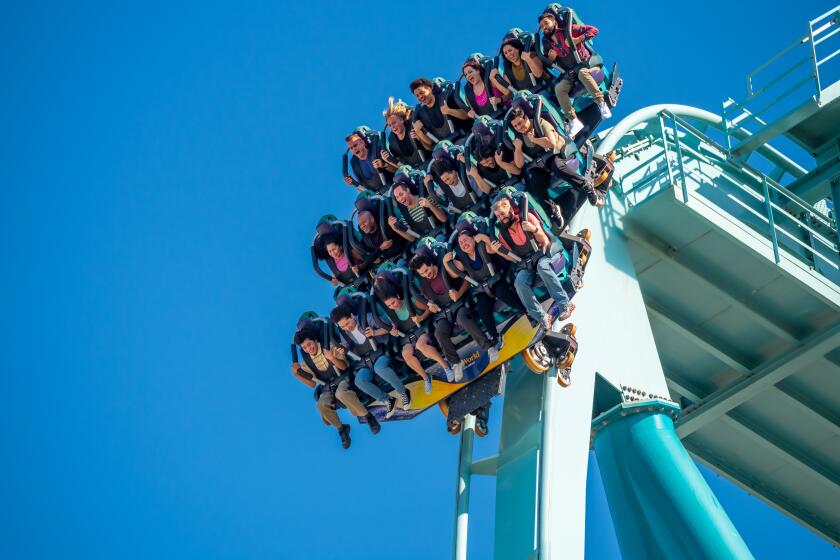SeaWorld attendance still lags pre-COVID times. So why did it just report record revenues?

- Share via
SeaWorld Entertainment continues to rebound strongly from the devastating effects of the pandemic, reporting Thursday that it saw record revenue during the second quarter even as attendance at its parks remains behind pre-COVID levels.
Total revenue grew to nearly $505 million — an increase of $65 million, or 14.8%, from the second quarter of 2021. Although it’s not surprising to see growth over the previous year, when many of the parks were still in the early stages of reopening, this year’s quarterly revenue also exceeded the second quarter of 2019 by $98.8 million, or 24.3%, the company said.
The increased revenue was driven largely by higher admission pricing, as well as more robust spending inside the parks on such things as food and merchandise. Per-capita admission and in-park spending reached record levels during the second quarter, which ended June 30, well ahead of 2019, the company said.
Admission and concession spending on a per-capita basis was up by a healthy 24.8% and 32.8%, respectively.
Because many of SeaWorld’s parks were still in the throes of capacity limitations a year earlier due to pandemic-related restrictions, the company also provided comparisons with 2019, before the arrival of COVID-19. The company reported similarly high net income, $116.6 million, the second-highest in a second quarter for SeaWorld. It also was more than 121% higher than the net income during the same period in 2019.
News of the record revenue drove SeaWorld shares up 4.2% to $51.07 on Thursday.
Despite the strong earnings, SeaWorld has more work to do, Chief Executive Marc Swanson said.
“While our second-quarter and first-half financial results were strong, these results still do not reflect a normalized operating environment and we still have significant scope to improve our execution and our financial results,” Swanson said. “International and group-related visitation is better than 2021 but not yet back to pre-COVID levels.”
During the second quarter, 6.3 million people visited SeaWorld parks, including the marine park in San Diego. That’s up by nearly 8% from the same period last year, but still down 3% from the second quarter of 2019, the company said. Blame it partly on a slow return of international visitors as well as group business, Swanson said.
Overall, international attendance is down by 50%, he said, while the decline in group-related business is in the teens. The SeaWorld parks, he said, have plenty of capacity to grow. Very few are the days when a park has to close its entrances because it is full, Swanson said. Those rare occasions may occur on a holiday such as the Fourth of July or New Year’s Eve.
Although other parks in the theme park industry have grown since 2008, SeaWorld still has yet to match its peak attendance level of more than 25 million people that year, Swanson pointed out. The Orlando, Fla., company lost considerable ground after the 2013 release of the anti-captivity film “Blackfish,” which helped fuel a plummet in attendance and revenue for some time.
“We’re under 22 million [during the last 12 months], so there’s a 3-million-plus gap,” Swanson told analysts during a Thursday morning earnings call. “Even if you look back at 2019, which we’re not even back to, that was 22.6 million. And 2008 was over 25 million and that was with one less park.”
SeaWorld Entertainment has made an unsolicited offer to purchase longtime theme park company Cedar Fair, which owns a dozen amusement parks, including Knott’s Berry Farm in Orange County.
What “excites” the company about its future business, Swanson said, is the prospect of capturing an additional 2 million to 3 million visitors annually.
Although SeaWorld does not break down revenues or attendance for individual parks, lease payments that the San Diego park makes to the city of San Diego for its Mission Bay site provide a window into how it is performing financially. The most recent lease payment, which was for May, was nearly $1.05 million, which represents a percentage of revenue from admissions and park concessions. That is considerably more than the $726,423 the park paid in May 2019, before the pandemic, suggesting that attendance at the San Diego venue has improved considerably.
Despite the improved outlook for revenues companywide, inflation and supply chain issues continue to weigh on SeaWorld. For the second quarter, total costs and expenses rose by $54.4 million, or 20%. SeaWorld Chief Financial Officer Elizabeth Gulacsy noted that as much as $25 million of company costs in the second quarter, when compared with 2019, are “temporary, unusual, inflation-driven costs we expect to moderate in the coming months.” They largely are related to energy, shipping, food and employee costs, she said.
On a bright note, SeaWorld executives are looking forward to a likely surge in visitation in September and October when the company will showcase special Halloween programming at its SeaWorld, Busch Gardens and Sesame Place parks. “Howl-O-Scream,” a separately ticketed nighttime Halloween event, will return to the San Diego and Orlando parks, and the Count’s Halloween Spooktacular will make its debut at the new Sesame Place park in Chula Vista, which replaced the former Aquatica water park.
More to Read
Sign up for Essential California
The most important California stories and recommendations in your inbox every morning.
You may occasionally receive promotional content from the Los Angeles Times.












